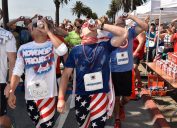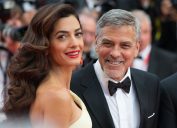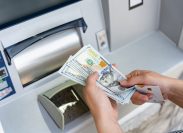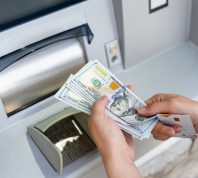Here's What Body Language Experts Are Saying about the Trump-Putin Summit
"It looks like a divorcing couple at crisis counseling."

On Monday, President Donald Trump met with Vladimir Putin in Helsinki for a widely-anticipated summit. After shaking hands and speaking briefly to reporters, the two leaders and their interpreters went into a private room together for a conversation spanning roughly two hours, then emerged for a press conference. Both stated that they had discussed a variety of critical issues regarding international security, and both said the negotiations had gone very well.
There's been no shortage of coverage—and outrage—over what the two men said once they addressed the media. For his part, Putin admitted that he wanted to Trump to win ("Yes, I did. Yes, I did. Because he talked about bringing the U.S.-Russia relationship back to normal"), while Trump raised more than a few eyebrows for appearing to take Putin's word about Russian efforts to hack the 2016 American election over reports by his own country's intelligence services (he holds "both countries responsible" and said that while he has "great confidence in [his] intelligence people," "President Putin was extremely strong and powerful in his denial today"). But for body language experts, the summit was more about what the two men didn't say.
Prior to their two-hour talk, Trump and Putin's body language was markedly odd, and many social media users commented that they looked like two people on an awkward Tinder date.
Can a body language expert please explain to me why Putin has his left hand clenched around his chair through the entire press conference? I have never seen a human sit like this. pic.twitter.com/kMfW2ZU0sy
— Diana (@BrukDiana) July 16, 2018
Joe Navarro, a former FBI agent and nonverbal communications expert, tweeted that the way Putin was gripping his chair with his left hand was a sign of "reluctance display," in which one person indicates an unwillingness to communicate with the person in front of them.
Reluctance displays pic.twitter.com/FRsZiiCy9M
— Joe Navarro (@navarrotells) July 16, 2018
Body expert Judi James said that "both men arrived performing the kind of alpha posturing you normally see in a boxing ring," but that, once in the room for the photo call, "they looked more like a sullen, divorcing couple at crisis counseling."
She added that both of them seemed to want to get the whole thing over with.
"Trump sat in his usual 'Trump Slump' pose with his legs splayed and his fingers in 'downward steeple' position to register macho dominance but this time his fingertips tapped together throughout which is a sign of impatience. Putin adopted a more elegant power pose, sitting upright with one elbow on the arm of the chair but as Trump spoke Putin's other hands clasped the lower strut of the chair arm as though irritation could have been making him keen to go."
One of the more comprehensive analyses of the press conference that followed came from body language and emotional intelligence expert Dr. Jack Brown.
According to Brown, the way Trump blushed and suppressed a smile when Putin was asked if the Russian government have any compromising material on President Trump or his family was a profound admission of guilt.
15/ Blushing with a suppressed smile alone would be enough – yet this set of nonverbal dynamics, clustered together in this context is PROFOUNDLY indicative of guilt. His blushing comes in a second wave precipitated by the Russian President's laughter/chuckling. pic.twitter.com/AxF9kcjQxI
— Dr. Jack Brown (@DrGJackBrown) July 17, 2018
"Trump's 'smile' in this moment is insincere – a pseudo-smile of bitterness (known specifically as a "Bitter Smile")," he wrote. "Crucially, although he eventually shakes his head side-to-side, the President initially nods his head up-and-down, signaling a subconscious 'Yes' to the implication of blackmail. By closing his eyes, Trump exemplifies a blocking phenomenon—psychologically distancing himself from the words/ideas from which he feels the need to insulate himself. Human beings will tend to look down and to their right during moments of guilt, shame, and emotional weakness—and here Trump shows us an example of this tell."
Trump's body language also indicated that he felt weak or powerless.
"On cue, Donald Trump moves his arms and hands from a forward, wide-spread, position on the lectern—to a retracted, protective configuration, with them momentarily pulled into his mid-line at the back of the lectern. This is a form of a fig-leaf (aka 'Genital Guarding') and the change is strongly significant for a considerably alpha emotional tone—downshifting to one which is quite beta. Trump is feeling vulnerable in this moment."
20/ On cue, Donald Trump moves his arms and hands from a forward, wide-spread, position on the lectern – to a retracted, protective configuration – with them momentarily pulled into his mid-line at the back of the lectern. pic.twitter.com/RhMyF3fa53
— Dr. Jack Brown (@DrGJackBrown) July 17, 2018
According to Brown, the fact that he looked over to Putin twice during the question shows that he is anxious, and that "doing so makes him look like/indicates he feels as a subordinate to Putin."
22/ Trump TWICE looks over at Putin – indicating his anticipation in the Russian's response. Trump is anxious. A person who is confident in their innocence would not have looked at Putin. Moreover, doing so makes him look like/indicates he feels as a subordinate to Putin. pic.twitter.com/QAfYQk3HXg
— Dr. Jack Brown (@DrGJackBrown) July 17, 2018
Putin's body language, meanwhile, oscillated between "placing his legs at a wide stance (more alpha)—back to one more narrowly spaced (more beta)—and then returning to a wider stance."
Brown said that he used conscious, deliberate, and theatrical gestures to indicate how dismissive he is of the accusations, which makes him appear to be disingenuously protesting the claims.
28/ During 1:03:39, as he says, "… compromising …", Putin gestures using a palm-down, head/neck-level illustrator – akin to brushing away an insect, a pest. This is action is conscious and deliberate. It is Putin in his theatrical mode, yet he's trying a bit too hard. pic.twitter.com/IBaddf35vq
— Dr. Jack Brown (@DrGJackBrown) July 17, 2018
"Simultaneously with his pseudo-fly swatting, and at additional multiple times during his response, Putin also displays Rationalization Rapport Empathy Expressions (R2E2). This facial expression (a pseudo-disgust face) shows his desire/attempt to gain our rapport as co-rationalizers. When it's seen this frequently (or at crucial moments), the R2E2 expression is highly suspect for deception.
30/ Simultaneously with his pseudo-fly swatting, and at additional multiple times during his response, Putin also displays Rationalization Rapport Empathy Expressions (R2E2). pic.twitter.com/cFgcAVXf0c
— Dr. Jack Brown (@DrGJackBrown) July 17, 2018
"When Putin said, 'When President Trump visited Moscow back then I didn't even know that he was in Moscow'…Putin elevates the distal portion (toes) of his right foot – rocking back on his right heel. In this setting, this foot maneuver indicates a deception associated with a high-anxiety emotional state… During 1:04:41 – 1:04:42, as Trump says, 'If they had it, it would have been out long ago,' Putin again raises his right foot in this same manner.'"
33/ … Putin elevates the distal portion (toes) of his right foot – rocking back on his right heel. In this setting, this foot maneuver indicates a deception associated with a high-anxiety emotional state. pic.twitter.com/gWPsYY9xnt
— Dr. Jack Brown (@DrGJackBrown) July 17, 2018
The summary of his analysis was as follows:
"After detailed nonverbal analysis of this portion of the Trump-Putin press conference, the findings strongly support the allegation that the Russian government has 'compromising material' (what the Russians call, 'kompromat') on Donald Trump and/or his family."
Fascinating stuff! And for more stories on the president's body language, don't miss the 5 Handshake Rules President Trump Breaks Every Time.
To discover more amazing secrets about living your best life, click here to sign up for our FREE daily newsletter!





















